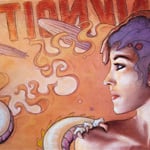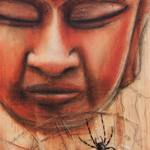Ken is in the process of creating a new teaching called “The Fourth Turning – Imagining the Evolution of an Integral Buddhism.” This teaching is being published as videos and an E-book this year and a new full hardcover book in 2015. This blog post is second excerpt of a summary of this new teaching.
Based on various types of research (which I’ll briefly explain in a moment), it appears that human beings have at least two very important—but very different—types of spiritual awareness. Forgive the technical terms here, but I think what is involved will become fairly clear. The first type is probably familiar to most: direct spiritual awareness, which involves what are technically called states of consciousness, and which are most often experienced in the practice of meditation or contemplation. For many meditative systems, there are between 3 and 5 major natural states of consciousness, and meditation is basically a systematic training to move through those states, starting at the lowest and densest and ending with the highest and subtlest (and ever-present, just not recognized). Both Vedanta and Vajrayana, for example, have versions of the following 5 states: 1) waking, 2) dreaming, 3) deep sleep, 4) empty or unqualifiable witnessing awareness, and 5) nondual “unity” awareness.
Each of those states of consciousness is said to be supported by a particular “body” (the states are said to be invisible and without simple location—where is “love” or “mutual understanding” located?—but the bodies are actual mass-energy forms running a spectrum from the grossest and densest to the subtlest and finest). These 5 bodies, supporting those 5 natural states of consciousness, are: 1) gross or physical body (Nirmanakaya in Buddhism—“kaya” means “body”), 2) subtle body (Sambhogakaya in Buddhism, 3) causal body (in Vedanta; “very subtle” body in Vajrayana, also called Dharmakaya or “Truth Body”), 4) Svabhavivakaya (in Buddhism, “Integrative Body”), and 5) Vajrakaya (in Buddhism, “Diamond Body”). Even when a system, such as Vedanta or Vajryana is aware of all 5 states and all 5 bodies, it is common for both of them to often just reduce these to 3 or 4, although always ready to draw on all 5 (Buddhism, for example, commonly reduces the bodies to the “trikaya”—the “three bodies”: Nirmanakaya [gross, form, or emanation body], Sambhogakaya [subtle, enjoyment, or transformation body], and Dharmakaya [very subtle or causal, Truth, or Emptiness Body]). Also, even though technically items like subtle body or causal body refer strictly to the body or mass-energy aspect, it is common to refer to the correlative state of consciousness with the same name—thus, gross consciousness, subtle consciousness, very subtle (or causal) consciousness, and so on.
Now the point about these states and bodies is that in most meditative systems, the meditative path itself starts at state 1 and progresses through the other states, in the order given, to state 5, or pure nondual Awakened Awareness. The point is that consciousness has passed through all states in full awareness, and thus achieves a type of “constant consciousness” that is itself the nondual union of Emptiness and Form—Emtpiness (or ultimate Dharma) not-two with all Form (gross form, subtle form, and very subtle form).
Thus, as for passing through the major natural states in that order (e.g., gross, subtle, very subtle, etc.), to give merely one example, Geshe Kelsang Gyatso gives the following 6 stages to Mahamudra meditation (Mahamudra, along with Dzogchen, are taken as some of the very highest of all Buddhist teachings):
1. Identifying our own gross mind
2. Realizing our gross mind directly
3. Identifying our subtle mind
4. Realizing our subtle mind directly
5. Identifying our very subtle/nondual mind
6. Realizing our very subtle/nondual mind directly
(Here, Gyatso uses the standard 3-state/realm summary—Nirmanakaya, Sambhogakaya, and Dharmakaya—or gross, subtle, and very subtle [the Tibetan term for “causal” is “very subtle”—so instead of “gross, subtle, causal,” it’s “gross, subtle, very subtle”]; this 3-state summary implicitly collapses the 4th-state witnessing mind and 5th-state non-dual empty mind—both of which are recognized by the Tibetans, but they often include them in the Dharmakaya or very subtle [or “causal”], which I have therefore summarized as very subtle/nondual. This is simple semantics. The point is that “gross, subtle, causal” is well-recognized by this Tradition, and meditation consists in moving through these states, making each one conscious, and then moving on to the next, “transcending and including” each.)
Thus, this general map of meditation stages comes from the natural states of consciousness all humans have (e.g., waking, dreaming, sleeping, ever-present nondual, etc.). This is probably why so many of world’s meditation systems are essentially so similar. Being biologically based (although not reducible to mere biology), they are the same for humans everywhere—in deep structure form, that is, while their surface features vary from culture to culture (and often within cultures). But, as only one example, Evelyn Underhill, in her classic text on Mysticism, claims all (Western) mystics go through the same basic stages of meditation: often following an initial awakening experience, the stages are: gross purification, subtle illumination, causal dark night (or infinite empty abyss, often followed by depression at losing the state before it becomes permanently realized), and nondual “unity” consciousness. The same basic gross, subtle, causal, nondual states are easily recognized. In fact, I did a book called Integral Psychology, which compared around 100 different developmental systems, about 1/3 of them being meditative systems and about 2/3 being similar to the type of spiritual awareness we will discuss next. What is so amazing about all of them—both types—is the essentially similar nature of them in each type, with similar stages easily recognizable in each (we’ll see this with the second type as well in a moment). In another book I co authored (with Jack Engler and Daniel P. Brown), called Transformations of Consciousness, we included a chapter by Harvard theologian John Chirban, who examined a dozen of the early desert Christian contemplatives and, yes indeed, the essentially same stages could be easily recognized (with those being similar to everything from St. Teresa’s Mansions to Zen’s Ox-Herding pictures).
So that is the first point I would like to make. Most schools of Buddhism (and most contemplative schools worldwide) have maps of meditation that are quite similar in deep structures. There are important variations, but there are also many, many important similarities, so much so that this deeply suggests some real and universal realities are involved here. The general stages of meditation, the types of awareness at each stage, and the general characteristics of each stage and the type of “knowledge” it delivers makes this entire area one to be taken with utmost seriousness. Meditation in general is delivering profoundly significant information about the human condition, the universe, and both relative and ultimate Truth.
So that’s the first basic type of spiritual awareness humans seem to have access to—direct immediate experiences, based on states of consciousness, and generally called spiritual experience. The second type (and again, please forgive some of the technical terminology here, but I think it will come out clear) involves something called, not states, but structures of consciousness, and is often referred to as spiritual intelligence. Spiritual intelligence has many different definitions, but the idea generally is that, unlike spiritual experience, which is a 1st-person immediate experiential reality, spiritual intelligence is a 3rd-person, intellectual response to questions like, “What is it that is of ultimate concern to me?” “What is ultimate reality like?” “Who am I?” (1st-person perspective is the person who is speaking, and is generally taken to mean subjective or personal experience; 2nd-person means the person being spoken to—a “you” or “thou”; and 3rd-person means the person or thing being spoken about, and is taken to mean an objective fact or scientific truth.) Saying that spiritual experience is “1st-person” means it is a subjective, immediate personal experience in the awareness of the person—like almost any meditative experience (and “subjective” doesn’t mean unreal; it can mean important truths about the subjective realm, which meditation certainly seems to deliver). On the other hand, saying spiritual intelligence is “3rd-person” means it is not necessarily directly in the awareness of the person, but has been established to likely be present by careful scientific research and experiment, even if it is not in the direct awareness of the person. So most people have a 1st-person experience of speaking English when they do—it’s a direct experience for them; and they usually speak it correctly, using the rules of grammar correctly, even though they can’t write down what the grammar rules are—those rules are 3rd-person elements in their mind, not 1st-person elements, like speaking the language itself is.)
So, spiritual and meditative experiences are 1st-person, direct, immediate, subjective experiences. Spiritual intelligence is a series of structures in the mind that are not themselves directly experienced; they are 3rd-person structures that empirical research has determined people everywhere have—like rules of grammar—even though they are not directly aware of these structures. That’s a basic difference between states of consciousness and structures of consciousness—states can be immediately seen by looking within, structures cannot be seen by looking within but are deduced by scientific experiments on large groups of people over long periods of time.
So you can determine a state of consciousness by simply and directly asking the person what they are thinking or feeling. This is why maps of meditative stages have been around for at least 50,000 years, going back to the original shamans and their voyages to the upper and under worlds. But structures of consciousness are very recent discoveries in human history, being not much more than 100 years old. But they turn out to be very, very important…. (The recentness of structures’ discovery is also why states are found in all meditative systems, but structures are found in none of them—something a new Turning would surely take into account.
In Ken’s next Fourth Turning blog post he summarizes the importance of multiple intelligences in any Fourth Turning of Buddhism in the 21st Century.
GO DEEPER
The Fourth Turning Media Collection
Use special code PTHEOS when purchasing the Fourth Turning Media Collection and receive a special discount.
The Fourth Turning Media Collection focuses on Ken’s NEW teaching videos on the evolution of Buddhism and how the Integral perspective informs the transformation of Buddhist teachings and practice in the 21st Century.
Once Ken has established the ground of the Fourth Turning inquiry, Diane Musho Hamilton, Doshin Michael Roshi and Patrick Sweeney teach and demonstrate practices with their respective sangha’s that suggest how what Ken is pointing out actually manifests in a Buddhist setting.
At lastly, other progressive and Integral authors, teachers and practitioners share their thoughts on what they think should be included in an inquiry into a 4th Turning of Buddhism from an Integral perspective.
The Fourth Turning Conference – April 4-6, 2014
Join us for this live historic three day event where we will deeply explore the Fourth Turning of Buddhism with Ken Wilber (live and in person) and Integral Buddhism teachers, Diane Musho Hamilton, Doshin Michael Nelson Roshi and Patrick Sweeney. Plus we will be joined by other skilled Buddhist authors and practitioners reflecting on the now and future of Buddhism from an Integral perspective.















